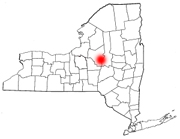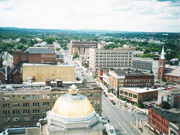If the Olympian motto ("faster, higher, stronger") could ever belong to a landscape, it would have to be sober, breathy, roomy Utica. This small city at the center of New York is mainly known for an ambitious park system which allows for both winter and summer sports facilities.
While quiet and orderly, and proud owner of some beautiful architecture, it is safe to say its soul beats at a very athletic 85 beats per minute. It's probably racing to leave it's past behind.

Pregnant with history as the best East Coast small-sized cities, Utica can take pride in one thing -- its history is its own and no-one else's. While affected by the evolution of both the U.S. and the cities around it, it has always marched its own way.
It all began with the construction of the Erie Canal in 1819 -- not only did the canal ran directly through town, but Utica was in the middle between each end of the canal and thus, a natural stop for its travelers. The currents of the Mohawk river helped feed its industrial machinery in a time when electricity wasn't all that developed. The blooming began: real estate skyrocketed and industries started to thrive, especially the cotton one. Utica evolved from a small isolated city to its own destination.
However, the textile industry started to fade halfway through the 20th century. Factories closed. Companies followed suit. By the 1950's, corruption and crime had taken hold of its streets, now known as "Sin City".
Its status fluctuated every decade or so, with the rise of radio manufacturing companies in the town helping the city make it to the 1990's and then disappearing again. This meant financial trouble for the local government, which was forced to shut down certain public services. Private business wasn't much better off -- jobs began to be scarce and the population began to seek better pastures elsewhere.

That's where the 21st century comes in. Citizens from war-troubled countries like Bosnia, Iraq, Cambodia or Thailand saw in desolate Utica a perfect gateway to the Land of Opportunities -- a town who needed people who needed a town. In true American fashion, it became a fresh start for both the immigrants (who, historically, have always been the engine that powered Utica's progress) and the city itself. Talk of revitalizing the city by thinking in the long term began, with a master plan looking 50 years into the future. "Sin City" is now known as "Second Chance City".